Chapter Overview
16
Century Change
3
Steps in Activity
4
Object Selection Criteria
3
Mediums for Still Life
What You'll Learn
History of Still Life
From symbolic objects in ancient art to main subject in 16th century.
Symbolic Meanings
Objects like Dharma Chakra, weapons, instruments in Indian art.
Activity 16.1
Arranging still life with objects, backdrop, and composition.
Modern Uses
Still life in ads, photography, sculptures beyond painting.
Historical Context
In Indian art, objects were symbolic in cave paintings, temple sculptures (e.g., wheel of law, swing). 16th century shift: objects main subject, arranged still, painted 3D/lifelike, called still life.
Key Highlights
Still life focuses on composition with varying objects; create visually interesting arrangements exploring contour/form/color/texture; used in ads; activity on choosing/arranging/drawing personal objects.
Comprehensive Chapter Summary
1. History of Objects in Art
From cave paintings to temple sculptures, objects integral but not main subject; depicted for symbolic meanings in composition, e.g., Dharma Chakra (wheel of law), weapons/musical instruments held by deities/courtiers.
2. Emergence of Still Life
16th Century Change
Objects became main subject; artists arranged/studied natural/human-made still objects.
Skill in Painting
Make appear three-dimensional/lifelike, hence called still life.
Mediums
Not restricted to drawing/painting; also photographs, sculptures.
3. Modern Applications
Advertisements
Used for product ads in magazines/hoardings/newspapers/TV.
A Few of My Favourite Things
Visually interesting compositional arrangement; explore contour/form/color/texture/relations; small groups by shared interests.
4. Activity 16.1: Arranging a Still Life
Step 1: Choosing Objects
Everyday/culture conveying identity (basket/clock/ball/toy/shoes/trophies/flowers/fruits); rare/unusual by local artists; 3-4 varying materials/colors/textures/sizes/dimensions.
Step 2: Choosing Backdrop
1-2 large single-colored cloth complementing, not distracting; or other material for plain backdrop focusing objects.
5. Composition Importance
Visually interesting leads eye to explore every object/perceive contour/form/color/texture/relate to others.
Questions and Answers from Chapter
Short Questions
Q1. What were objects in ancient art?
Answer: Integral but not main subject.
Q2. How depicted in Indian art?
Answer: For symbolic meanings.
Q3. Example of symbol?
Answer: Dharma Chakra.
Q4. When big change?
Answer: Around 16th century.
Q5. What became main subject?
Answer: Objects.
Q6. What artists interested in?
Answer: Arranging/studying still objects.
Q7. Skill in painting?
Answer: Appear 3D/lifelike.
Q8. Why called still life?
Answer: Objects remain still, life added.
Q9. Not restricted to?
Answer: Drawing/painting.
Q10. Also in?
Answer: Photographs/sculptures.
Q11. Used for?
Answer: Product advertisements.
Q12. In what media?
Answer: Magazines/hoardings/newspapers/TV.
Q13. Important in still life?
Answer: Visually interesting composition.
Q14. Leads eye to?
Answer: Explore every object.
Q15. Perceive what?
Answer: Contour/form/color/texture.
Medium Questions
Q1. Describe objects in ancient art.
Answer: Integral part, symbolic meanings, not main subject, in cave paintings/temple sculptures. (3 marks)
Q2. Give examples of symbols.
Answer: Dharma Chakra (wheel of law), weapons/musical instruments held by deities/courtiers. (3 marks)
Q3. What change in 16th century?
Answer: Objects main subject, arranged natural/human-made still objects. (3 marks)
Q4. Skill in still life painting?
Answer: Appear three-dimensional, add life to still objects. (3 marks)
Q5. Still life in other forms?
Answer: Photographs, sculptures, besides drawing/painting. (3 marks)
Q6. Modern use of still life?
Answer: Product advertisements in magazines/hoardings/newspapers/television. (3 marks)
Q7. Importance of composition?
Answer: Visually interesting, explore contour/form/color/texture/relations. (3 marks)
Q8. Make small groups how?
Answer: According to shared interests before activity. (3 marks)
Q9. Step 1: Choosing objects.
Answer: Everyday/culture identity, rare/local artists, 3-4 varying materials/colors/textures/sizes/dimensions. (3 marks)
Q10. Examples of objects?
Answer: Basket/clock/ball/toy/shoes/trophies/flowers/fruits. (3 marks)
Q11. Step 2: Backdrop.
Answer: 1-2 large single-colored cloth complementing, not distracting; or other plain material. (3 marks)
Q12. If no cloth?
Answer: Use any material creating plain backdrop focusing objects. (3 marks)
Q13. What in Kangra painting?
Answer: Swing as symbol. (3 marks)
Q14. What in Sanchi Stupa?
Answer: Wheel as symbol (Wheel of Dharma). (3 marks)
Q15. Why enjoy making?
Answer: Know minutest details of chosen objects. (3 marks)
Long Questions
Q1. Discuss objects in Indian art history.
Answer: From cave paintings/temple sculptures, integral part artworks but never main subject; depicted convey symbolic meanings, integral composition; e.g., Dharma Chakra/weapons/musical instruments held deities/courtiers.
Q2. Explain emergence of still life.
Answer: Around 16th century big change; objects main subject artworks; artists interested arranging/studying variety natural/human-made remain still; skill painting appear three-dimensional/life added; called still life.
Q3. Describe still life in various mediums.
Answer: Not restricted drawing/painting; artists create compositions photographs/sculptures too; today used create product advertisements magazines/hoardings/newspapers/television/so on.
Q4. Analyze importance of composition.
Answer: Very important visually interesting compositional arrangement; leads eye explore every object perceive contour/form/color/texture/relate others placed around it.
Q5. Discuss grouping for activity.
Answer: Make small groups according shared interests before beginning activity; enjoy because know minutest details chosen objects.
Q6. Explain Step 1: Choosing objects.
Answer: Choose objects everyday life/culture convey identity/belonging; e.g., basket/clock/ball/toy/shoes/trophies/flowers/fruits; search rare/unusual made local artists along complement; select 3-4 varying materials/colors/textures/sizes/dimensions.
Q7. Describe Step 2: Choosing backdrop.
Answer: Select 1-2 large pieces single-coloured cloth create backdrop; color not distract attention objects, rather complements; if no cloth, use other material create plain backdrop objects focus.
Q8. How make still life visually interesting?
Answer: Arrangement leads eye explore every object; perceive contour/form/color/texture; relate other objects around it.
Q9. Discuss symbolic examples.
Answer: Wheel Symbol (Wheel of Dharma) in Stone Carving, Sanchi Stupa; Swing as Symbol in Kangra Painting.
Q10. Explain why called still life.
Answer: Manner painting not only appear three-dimensional but as if life added them; objects remain still yet lifelike.
Q11. How objects in ads?
Answer: Still life compositions create product advertisements magazines/hoardings/newspapers/television/so on.
Q12. Describe activity preparation.
Answer: In still life important have visually interesting compositional arrangement; make small groups according shared interests.
Q13. Why choose personal objects?
Answer: Convey identity/belonging; enjoy making know minutest details.
Q14. What varying in objects?
Answer: Materials, colors, textures, sizes, dimensions.
Q15. Purpose of backdrop?
Answer: Create plain so objects focus; complement, not distract.




